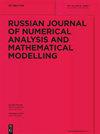论计算具有周期性不连续初始数据的柯西问题时冲击捕捉方案的准确性
IF 0.6
4区 数学
Q4 MATHEMATICS, APPLIED
Russian Journal of Numerical Analysis and Mathematical Modelling
Pub Date : 2024-04-08
DOI:10.1515/rnam-2024-0009
引用次数: 0
摘要
我们研究了具有片断光滑不连续初始数据的浅水 Cauchy 问题的冲击捕捉方案的精度。我们考虑了二阶平衡特征(CABARETM)方案、三阶有限差分 Rusanov-Burstein-Mirin (RBM) 方案和空间五阶、时间三阶加权基本非振荡(WENO5)方案。我们已经证明,精确解的最大精度损失出现在中心稀释波中,所有这些方案都具有一阶收敛性和相当接近的数值失衡(误差)值,无论它们对平稳解的形式近似阶数如何。同时,在冲击影响区域内,所考虑的方案可能具有不同的收敛阶数,因此精度也大不相同。特别是在求解具有周期性初始数据的 Cauchy 问题时,当精确解没有中心稀释波时,与 CABARETM 和 WENO5 方案相比,RBM 方案在冲击影响区域内具有更高的精度。这说明以 RBM 方案为基本方案、CABARETM 方案为内部方案的组合方案可以有效地用于计算这类 Cauchy 问题的弱解。本文章由计算机程序翻译,如有差异,请以英文原文为准。
On the accuracy of shock-capturing schemes when calculating Cauchy problems with periodic discontinuous initial data
We study the accuracy of shock-capturing schemes for the shallow water Cauchy problems with piecewise smooth discontinuous initial data. We consider the second order balance-characteristic (CABARETM) scheme, the third order finite-difference Rusanov–Burstein–Mirin (RBM) scheme and the fifth order in space, the third order in time weighted essentially non-oscillatory (WENO5) scheme. We have shown that the maximum loss of accuracy occurs in the centered rarefaction waves of the exact solutions, where all these schemes have the first order of convergence and fairly close values of the numerical disbalances (errors), regardless of their formal approximation order on the smooth solutions. In the same time, inside the shock influence areas the considered schemes can have different convergence orders and, as a result, significantly different accuracy. In particular, when solving the Cauchy problem with periodic initial data, when the exact solution has no centered rarefaction waves, the RBM scheme has a significantly higher accuracy inside the shock influence areas, compared to the CABARETM and WENO5 schemes. It means that the combined scheme, in which the RBM scheme is a basic scheme and the CABARETM scheme is an internal one, can be effectively used to compute weak solutions of such type Cauchy problems.
求助全文
通过发布文献求助,成功后即可免费获取论文全文。
去求助
来源期刊
CiteScore
1.40
自引率
16.70%
发文量
31
审稿时长
>12 weeks
期刊介绍:
The Russian Journal of Numerical Analysis and Mathematical Modelling, published bimonthly, provides English translations of selected new original Russian papers on the theoretical aspects of numerical analysis and the application of mathematical methods to simulation and modelling. The editorial board, consisting of the most prominent Russian scientists in numerical analysis and mathematical modelling, selects papers on the basis of their high scientific standard, innovative approach and topical interest.
Topics:
-numerical analysis-
numerical linear algebra-
finite element methods for PDEs-
iterative methods-
Monte-Carlo methods-
mathematical modelling and numerical simulation in geophysical hydrodynamics, immunology and medicine, fluid mechanics and electrodynamics, geosciences.

 求助内容:
求助内容: 应助结果提醒方式:
应助结果提醒方式:


